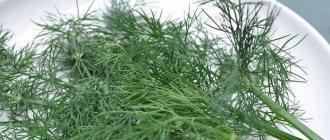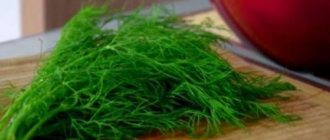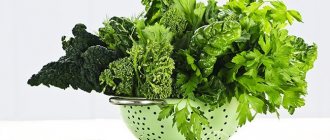Not every housewife knows how to store herbs in the refrigerator. For many, in just 1–2 days, the herbs dry out or wither, or even become completely covered with mucus. They not only become tasteless, but also lose almost 100% of their nutrients. It’s good when there is a vegetable garden nearby, from where you can pick another bunch of fresh dill, parsley or green onions. And if not? Then all that remains is to apply methods for long-term storage of greens - and we will tell you about them in detail.
You need to know this
Before we talk about how to keep greens fresh longer in the refrigerator, it’s worth talking about some nuances. To follow the recommendations correctly, you should learn about preparing greens.
Do you need to wash your greens?
Many people say that it is necessary, but it is not so. There are several storage methods in which unwashed greens are preferable. Therefore, we advise you to read the recommendations carefully.
How to properly wash greens?
It is not recommended to rinse greens under high pressure of water. This way you risk damaging it. After this, it will begin to rot, turn yellow, and lose its taste. It is better to spend more time, but keep the foliage and stems intact.
This amount of water is enough to rinse the greens well and not harm them.
How to prepare greens?
Before storing, be sure to sort out the greens. Pay special attention to rotting leaves and stems. They need to be trimmed so that there is no rot left at all. It is also necessary to remove dried and yellowed areas.
How to store greens in the refrigerator?
Any material is suitable for storage, with the exception of unpainted metal. Upon contact with it, some types of greens lose their taste and appearance. It is best to use utensils from:
- Plastic;
- Glass;
- Ceramics.
Where to store greens?
Traditionally, greens are stored in vegetable and fruit boxes. The lowest temperature is maintained there. Due to this, the risk of rotting and the appearance of pathogenic bacteria is lower. But if you're storing your greens dry, in an airtight container, the entire bottom half of your refrigerator will do.
It is important to remember that the higher the greens and the greater the temperature differences in the chamber, the less time they will be stored. This is another reason why you should not put hot food in the refrigerator.
Cleanliness is the key to freshness
This method of storing greens in the refrigerator is suitable if you have a lot of them. In addition, it must be of the same type. You should not store dill, sorrel and parsley at the same time. To keep it fresh you need:
- Rinse the greens thoroughly;
- Dry it with paper or a towel;
- Let dry in the shade for 10-15 minutes.
After this, select a suitable container. It is important that the greens fill the maximum volume. But it is not recommended to break it; avoid damaging the leaves.
What to do if the greens are wilted
A few simple tips on how to restore aromatic herbs:
- Prepare a nutrient solution: dilute 2 tsp in 1 glass of water. vinegar. Place the greens in the solution for 1 hour. This will restore its freshness. The same effect will occur if you take fresh lemon juice.
- A contrast shower will help restore green plants to their former appearance. Place the greens first in hot water and then in cold water.
- The parsley will become more fragrant if you rinse it with warm water.
- If you need to refresh the salad, you can simply rinse the leaves with warm water or soak in it for 15 minutes.
- Renew the cuts of dill and parsley. Prepare a cup or jar of water. Place the greens in a container like a flower bouquet. You can also sprinkle it with additional water on top.
Give it a drink before storing
This is one of the most effective and easiest ways to keep greens fresh in the refrigerator. But it is not suitable for arugula, green onions and salad. For any other type of green it works great.
First you need to cut off the roots of the greenery. After this, rinse it thoroughly and remove all rotten and yellowed leaves and stems. After this, tie them into bundles with threads or elastic bands.
Find a large plastic container. The lid must close tightly. Place the greens in it so that they do not reach 1-2 cm to the top. The bundles should lie freely, without pressure.
Fill it with enough cold water to cover all the greens. It is advisable to use filtered water. After this, place the container in the refrigerator for 6 or more hours. The best option is for the night.
After time has passed, remove the bunches of greens from the container. Let the water drain from them, shake lightly. Drain the container, but do not wipe it dry. Place the bundles back and seal the lid.
To prevent the greenery from rotting, swap the lower bunches with the upper ones every 1-2 days . Greens in such a container will be stored much longer than in the lower drawers of the refrigerator. But it is advisable to store it as low as possible in the chamber.
LiveInternetLiveInternet
It should be remembered that the main enemy of the vitamins contained in greens is light and heat. When exposed to sunlight, vitamin C is lost faster in greenery - a few hours are enough for this. Therefore, green vegetables should only be stored in the refrigerator, preferably in a tightly closed bag or container. There are several ways to store greens, choose any one.
To always have truly fresh greens on the table, use the following tips:
So, greens can be stored in the refrigerator for at least a week using one of the following methods: Tip 1. The easiest way is to rinse the greens with cold water. It is advisable not to wash under running water, but to fill a deep saucepan with water and immerse the greens in the water. And then finally rinse under the tap. Then place the washed and shaken greens on paper kitchen towels. We need to dry the greens as best as possible. Blot large drops of water and place the greens on the table, let them dry for about fifteen minutes. Next, pack in a spacious container with a tight-fitting lid (a vacuum sealer is even better). If there is no container, then take a clean, dry liter jar, put the greens in it and close the jar with a clean plastic lid. That's all. Keep refrigerated. In this form, the greens stand quietly for a month and do not spoil or even turn yellow.
Tip 2. To keep greens and leafy vegetables fresh for several days, you should carefully sort them out (throw away spoiled ones), rinse them, let the water drain and place them in a plastic bag. Then open it wide so that the maximum amount of air can get into it, and tie it tightly. Keep in the refrigerator on the bottom shelf.
Tip 3. Greens can be stored for 2-3 weeks if, before storing, rinse them well, let the water drain, pat dry with a towel, and wrap in paper (not waxed). Kraft paper or a thick paper towel are well suited for this method, the main thing is that the paper does not unravel from moisture. Wrap the clean herb completely in a towel. Spray the paper with water from a flower spray bottle or wet it under the tap. Place the bundle in a plastic bag and place it in the refrigerator. Do not use newsprint - printing ink is harmful to the body.
Tip 4. For long-term storage of greens, they should be sorted, but not washed. Then place in a plastic bag along with 1-2 onions, unpeeled and cut into four pieces, and tie. Store in a cool place. Every 4-5 days, take everything out, wipe the bag dry and put the greens back into it, replacing the onions with fresh ones. Tip 5. If you don’t have time, you can simply wrap fresh greens immediately after purchase in a waffle towel and put them in the refrigerator.
Tip 6. Green onions, celery, lettuce, spinach, parsley, and dill can be stored in the refrigerator for quite a long time if they are dry. There is no need to wash such greens before storing them - just sort them out, dry them on paper and put them in a plastic bag, making several holes in it with a fork for ventilation. Celery greens in a plastic bag can remain fresh in appearance for 5-6 weeks, lettuce cut together with the stalk - 1-1.5 months, spinach - almost all winter. Tip 7. Parsley and dill can be stored like flowers, placed in a glass of water: cut off the roots of fresh herbs, put a bunch of greenery stems in a jar or glass of water, cover the leaves of the greenery with a plastic bag on top (or wrap the leaves with damp gauze or other clean cloth), change the water once every two days
Tip 8: Lettuce will stay fresh and crisp all week if you place it on a plate, place a paper towel on top, and cover with cling film.
Tip 9. Green onions can be kept fresh for two to three weeks if you sort them, moisten the roots with cold water and leave the feathers dry. Then wrap the roots with the onion with a wet rag, and on top of the rag, wrap the roots with the onion in paper, tie it at the base of the feathers with twine, place it in a plastic bag and put it in the refrigerator.
Freezing greens as a storage method For longer storage of greens, they should be frozen. To do this, you need to wash fresh greens, wait until they are dry from moisture, cut off their stems, and throw away the rotten parts. Then place the green leaves in bags or airtight containers in the freezer of the refrigerator. To properly rinse greens in a large amount of water, it is recommended not to drain the water after washing the greens, but to remove the greens from it so that the sand remains at the bottom of the dish and not on the greens themselves.
- Classic. Chop the greens, put them in a plastic bag and put them in the freezer
- It is recommended to chop parsley, sage and thyme, and it is better to freeze them in tightly sealed plastic containers
- It is recommended to freeze dill and mint in small portions wrapped in foil: divide the dill and mint into portions. Wrap each piece in food foil and place in the freezer.
Each type of greenery can be pre-labeled on foil with a marker (for example, mint - m, dill - y), for faster and more convenient searching in the freezer. This method is quite effective in terms of storing greens all year round and you can freeze a fairly large amount of greens. It is recommended to sprinkle basil and rosemary leaves on top with salt and freeze them in tightly sealed plastic containers; remove the salt before use. Store chopped green onions in the freezer in plastic bottles. Just make sure the onions are completely dry before you put them in the bottle.
- And one more, in my opinion, interesting way to freeze fresh herbs: Wash a mixture of herbs (anything: basil, cilantro, dill, parsley, etc.), dry with a towel and place on a layer of plastic wrap in the form of a thick sausage. Wrap the “sausage” very tightly and, to be sure, tie it along the entire length with thread (you can use a rubber band).
Don't use salt! Place in the freezer. In my freezer I have a place on the side reserved for such a log with herbs. I don't sign, you can sign using masking tape. If necessary, take it out, bend the plastic and cut with a knife as much as you need directly into the plate with the soup. Or remove the film and cut - the greens cut very well and do not lose their flavor! There is another original way - freezing fresh herbs in ice cubes. To do this, you need to finely chop the leaves of fresh herbs and place them in ice trays supplied with the refrigerator, fill the molds with the herbs with water and place them in the freezer. Store the finished cubes in a bag or box in the freezer. It is very convenient to throw such a cube into a pan with soup (or other dish) when the soup has already been cooked. As an option, you can freeze greens in this way: Fill ice cube trays with greens, add olive oil or melted butter, and put them in the freezer. Then you can add it to salads or potatoes!
How to refresh wilted greens If the greens have wilted, then to restore their freshness it is enough to hold them for an hour in cold water, slightly acidified with vinegar (1 teaspoon per half glass of water)
If you rinse parsley in warm rather than cold water, it will become more fragrant. Wilted lettuce leaves can be refreshed by rinsing them or soaking them in warm water for 15 minutes. Wilted green vegetables will become fresh again if you dip them first in hot and then in cold water.
Source: https://mam2mam.ru/club/blog/Mamam-na-zametku/vse-sekrety-dlitelnogo-khraneniya-zeleni/
Long-term preservation of green onions
To keep your greens fresh for as long as possible, you will need onions. Depending on the volume, you need 1-2 onions. To keep greens for a long time, do the following:
- Wash the roots from the soil, but do not touch the green part;
- Cut the onion into 4-8 pieces (depending on size);
- Place chopped onions in the bottom of a container or other container;
- Place greens on top;
- Change the bulb when it stops smelling.
With this storage method, the greens will be fresh for several weeks. The time for replacing onions is individual, depending on the volume of the container and the size of the onion. The main thing is to remember to check whether the onion gives off a characteristic smell.
General recommendations
Greens are not a fastidious crop when it comes to storage, but often difficulties arise when they begin to rot the very next day after harvest.
When storing greens, follow the recommendations:
- Avoid sudden changes in temperature. This will cause the greens to quickly wither or begin to rot.
- Observe temperature conditions. The optimal temperature for storing it is 7-13 degrees Celsius. In this case, it will retain its taste and valuable properties for a long time.
- Avoid high or low humidity in the storage area. In the first case, the greens may begin to rot quickly, and in the second, they may dry out and wither.
- Keep it away from direct sunlight unless it is drying naturally. It is better to choose dark places.
- Avoid storing greens outside of the refrigerator for long periods of time. This is due to its rapid deterioration when oversaturated with oxygen.
When properly stored, greens not only retain their beneficial properties, but also their rich and vibrant taste - both fresh and cooked.
Napkins and towels
A great way to maintain optimal humidity is to use napkins or paper towels. You will also need a plastic container or other container with high walls. To prepare everything you need:
- Wash and dry the greens;
- Line the bottom and walls with paper;
- Place greens up to half the height of the container;
- Cover the container with paper and a lid.
With this storage method, the paper absorbs excess moisture. And a tightly closed lid prevents it from leaving completely. Optimal humidity is maintained. From 10 days - this is the shelf life of almost all types of greens using this method.
Layering greens on paper napkins in a container.
How to store green onions in the refrigerator
To keep green onions in the refrigerator for a long time, rinse their stems. Do not touch the bulbs, especially if there is soil left on them. Dry the stems and gently moisten the bulbs with water. It is better to use a spray bottle.
Place all the onions (not one at a time, but together) in a small disposable plastic bag. Tighten it with a hair elastic or tie it with thread. The binding should be just above the bulb , where the stem is white and hard. When storing, make sure that the feathers do not break.
How long to store dill and parsley in the refrigerator
Parsley and dill are traditional greens on our table. There are three traditional ways to store dill in the refrigerator:
- Trim the roots and place them in a glass of water. At the same time, make sure that there are no rotten or yellowing branches. If there are, get rid of them.
- Place the dill in a ziplock bag or container with the chopped onion. Change the onion every 5-10 days.
- Line a container with paper towels and fill it halfway with dill. Cover with a napkin and close tightly.
How to properly store lettuce leaves in the refrigerator
To preserve the taste of the salad, use plastic, enamel or ceramic dishes. When in contact with metal, it loses its taste . It is advisable not to cut it, but to tear it off. After preparing the sheets, lay them down as quickly as possible so that their appearance is not lost. There are several ways to store salad in the refrigerator.
Method No. 1
- Sort through the lettuce leaves, select fresh ones;
- Rinse them and dry them on a paper towel or napkin;
- Place it in a container or container;
- Cover with a paper towel, thin cloth, or perforated plastic.
Method No. 2
- Pour water into a glass or jar;
- Cut 1-1.5 cm of cuttings from the lettuce leaves, so that part of the leaf is cut off;
- Roll several leaves into a kind of “bouquet” without breaking them;
- Dip the resulting “bouquet” of cuttings into water.
Method No. 3
- Sort through the lettuce leaves, but do not rinse;
- Place it on a polystyrene foam tray;
- Cover it tightly with cling film.
Foamed polystyrene tray (expanded polystyrene)
Method 2: glass plates and jars
Let's deal with plates and large containers.
Step 1. Prepare the greens for harvesting
|
Step 2: Prepare the dishes
|
Step 3: Stack the greens
|
Step 4: Place a paper towel on top
|
Step 5: Close the container
|
Now consider the option with glass jars.
Step 1: Prepare the greens
|
Stage 2. Prepare the container
|
Stage 3. Fold the shoots
|
Step 4. Close the container and store
|
Standard shelf life for greens
| Green onions | 7-10 days |
| Parsley | 3-5 days |
| Arugula | 2-3 days |
| Salad | 1 Week |
| Celery | 1-2 weeks |
| Asparagus | 3-4 days |
| Dill | 3-5 days |
| Spinach | 3-5 days |
| Sorrel | 4-5 days |
In this post, we talked about how to keep greens fresh longer in the refrigerator. We examined in detail the issues of storing green onions, dill, parsley, lettuce, arugula and spinach. We hope it was useful. Don't forget to share the post with your friends!
Do you want to get help from a master, a specialist in this field? Go to the professional search portal. This is a completely free service where you will find a professional who will solve your problem. You do not pay for posting an ad, views, or choosing a contractor. If you are a master of your craft, then register on Pro and receive a flow of clients. Your profit is just one click away!
Containers, available materials
If the refrigerator has a special compartment for placing green products, there will be no problems with choosing a container. In its absence, use various available materials:
- Vacuum bags. The peculiarity of this container is the absence of air and high humidity inside. This is the best way. This is how greens stay fresh for up to a month: onions - 30 days, parsley, dill and their other families. - 3 weeks. The principle is that, after placing the product in the package, the air is pumped out of it. Products made from polypropylene are most preferred. Cheap ones often break the seal. Greens are stored in such containers in sprigs or chopped form.
- Glass. Instead of vacuum containers, use jars that are tightly closed with nylon or glass lids. A good microclimate is created inside them to preserve the green environment. Herbs stay fresh for 2-3 weeks. The containers themselves are safe for humans, but they take up a lot of space in the refrigerator and accumulate condensation inside them, which must be released periodically.
- Plastic container. To store herbs, use containers with lids that are tightly closed, preventing the penetration of oxygen into it. In them, the leaf remains fresh for 2-3 weeks. Sorrel, parsley, and lettuce feel especially good.
- Plastic bags are the simplest and most affordable means of storage. If you put parsley, onion, dill in them and blow out the air, the cut plants will remain green for a week.
- Packaging paper is often used, but is not highly effective. The material is not airtight and gets wet quickly. Due to high humidity and free access to air, greens lose their freshness after 5–7 days.
- Textile. With this method, cotton napkins or towels are used. Before wrapping the herbs, the material is moistened with water. It is possible to keep plants fresh in fabric for 1–2 weeks.
If you wish, you can try each method and choose the most correct one.











